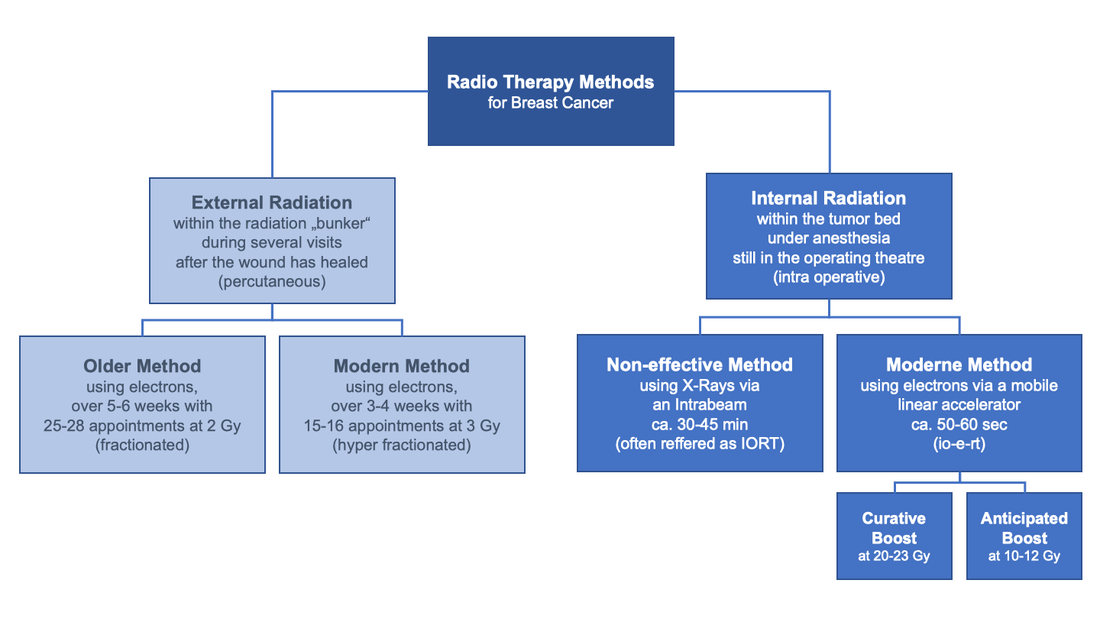2020 Updates: ASTRO, ESTRO, NCCN and German DEGRO guidelines confirm IOeRT and the end of x-ray treatments
Read the latest medical publications from 2020 about IOeRT (intra-operative radio therapy using electrons) confirming that the former kv iort method using x-rays should no longer be used as a treatment methods outside of trials...
Breast Cancer Congress in Vienna: Long-term study confirms success of intraoperative radio therapy
Overview of the Radiation Methods for Breast Cancer Treatments
June 2017: New publication by Prof. Dr. Sedlmayer on IOERT
Intra Operative Electron Radio Therapy as a breast cancer treatment
Today's standard in modern oncology is a multimodal therapy, which may consist of a combination of surgery, radiation and chemotherapy. The surgical removal of the tumor is in most cases the basis of the therapy. Many years of research and international studies show that despite the complete tumor removal, the risk of a recurrence of the tumor at the surgical site is very high. The aim of the additional radiation therapy is to destroy the cancer cells using the highest possible radiation dose without affecting the surrounding healthy cells. Intraoperative radiation therapy (IOERT) enables the high-dose, targeted radiation during tumor surgery within the operation theatre. It allows for very accurate dosages and doctors can protect healthy tissues.
Benefits for cancer patients
+ MORE EFFECTIVE TREATMENT DIRECTLY IN THE OPERATING ROOM
+ SHORTER TREATMENT TIMES
+ VERY FEW OR NO THERAPY SESSIONS
+ LESS RADIATION ABSORBED BY PATIENT
+ FEWER COMPLICATIONS FROM RADIATION SIDE-EFFECTS, ESPECIALLY ON THE SKIN
+ SHORTER TREATMENT TIMES
+ VERY FEW OR NO THERAPY SESSIONS
+ LESS RADIATION ABSORBED BY PATIENT
+ FEWER COMPLICATIONS FROM RADIATION SIDE-EFFECTS, ESPECIALLY ON THE SKIN
15,270 Australian cases of breast cancer in 2014*
Intraoperative Electron Radiation Therapy (IOERT) is considered the most effective type of IORT cancer treatment by many experts. The main difference of IOERT compared to IORT is the use of electron-beams instead of x-rays. X-rays have poor depth distribution and often penetrate beyond the tumour bed to the normal tissues beneath which typically takes longer to administer. Treating the cancer patient with electron beams delivers the required dose much faster than x-ray beams and can be performed without moving the patient off the operating table, since mobile linear accelerators - like the LIAC shown in the video - are very maneuverable. Just one minute of IOERT replaces five weeks of external beam radiation therapy, previously necessary for post-operative patients, which significantly improves the quality of life during and after the breast cancer treatment.
In July 2007 the Australian National Breast Cancer Centre listed the following theoretical benefits of IORT when compared to
postoperative radiotherapy:
In July 2007 the Australian National Breast Cancer Centre listed the following theoretical benefits of IORT when compared to
postoperative radiotherapy:
- IORT is applied directly to the tumour bed rather than relying on simulation techniques to estimate the area to be irradiated
- dose attenuation and the ability to physically move soft tissue around the applicators reduces irradiation of surrounding tissues and organs
- administration of a precise target volume in a single dose to the target area allows more targeted treatment
- there is virtually no delay between surgery and delivery of radiation therapy
- for patients who are unable or unwilling to have postoperative radiotherapy, IORT provides a way of delivering at least some radiotherapy
3,030 Australians died from breast cancer in 2014*
In 2004 the Australian Safety and Efficacy Register of New Interventional Procedures - Surgical already listed the following IORT advantages over postoperative electron beam radiotherapy:
* http://www.aihw.gov.au/WorkArea/DownloadAsset.aspx?id=60129550202
- IORT spares normal tissues by marked dose attenuation.
- There is a greater physical capacity to move/retract normal soft tissue around the applicators to minimise irradiation of normal tissue.
- The radiation dose can be delivered directly to the tumour bed with minimal chance of geographic miss as a direct visualisation approach is used rather than relying on “simulation” and “target approximation” techniques.
- There is virtually no delay between surgery and the irradiation of any residual cancer cells.
- A larger single dose can be administered because the radiation field can be more precisely tailored to the target volume than in conventional postoperative radiotherapy.
- The entire course of radiotherapy treatment could possibly be shortened to only one intraoperative episode or the postoperative boost dose could be eliminated (provided that a sufficiently high intraoperative dose could be tolerated by the
patient). - The new mobile technology affords greater radiation protection to hospital personnel.
* http://www.aihw.gov.au/WorkArea/DownloadAsset.aspx?id=60129550202

